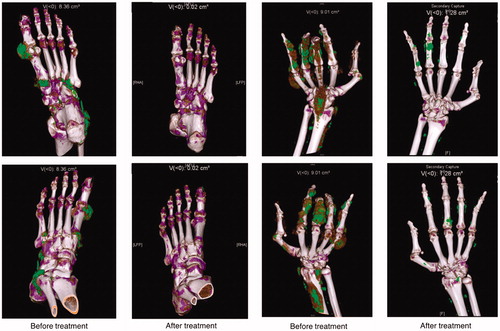Figures & data
Table 1. Patients’ age, change in MSU load, average serum urate and urate lowering therapy.
Figure 1. Distribution of MSU crystal before and after treatment. The paired foot and ankle DECT images belong to Patient 28. MSU load in the left foot reduced 99.9% from 8.36 cm3 to 0.02 cm3. The paired hand and wrist DECT images belong to patient 17. MSU load in the right hand reduced 86% from 9.01 cm3 to 1.28 cm3. Flexion contracture in middle finger improved. Power grip improved 2.8 times. (Remark: Green colour represents MSU crystal).

Figure 2. (a and b) Serum urate as a function of monthly tophi dissolution rate drawn in comparison to Perez-Ruiz et al. [Citation9] (a) Dissolution graph of combined MSU load at simple rate; (b) Dissolution graph of combined MSU load at compound rate).
![Figure 2. (a and b) Serum urate as a function of monthly tophi dissolution rate drawn in comparison to Perez-Ruiz et al. [Citation9] (a) Dissolution graph of combined MSU load at simple rate; (b) Dissolution graph of combined MSU load at compound rate).](/cms/asset/d76afbe9-1328-4cc6-92a6-15d7e03e3168/imor_a_1825053_f0002_b.jpg)
Figure 3. Prediction of MSU (tophi) reduction rate and time with serum urate level. (a) Compound monthly dissolution rates as a function of serum urate level between 0.18 to 0.48 mmol/l (Solid line – linear regression line, dotted lines – the limits of 95% confidence interval). At 0.36 mmol/l, the compound monthly dissolution rate was 8.5% on the average, at 0.30 mmol/l around 14%, and 0.24 mmol/l around 20%. (b) MSU dissolution model helps us to understand the dissolution process. It is dissolution time as a function of serum urate for representative dissolution percentages (t99 = time for 99% MSU dissolution, t90 for 90%, t75 for 75% and t50 for 50%). The upper end of the curves reflects situation with failed ULT. Some degree of dissolution may still be possible up to 0.43 mmol/l (7.2 mg/dl). Complete dissolution is impractical if SU > 0.36 mmol (6 mg/dl). By extrapolating our data towards zero SU, the lower end reflects cases responding to pegloticase. It still takes 4–8 months to dissolve most MSU crystal when SU approaches zero. At each SU level, dissolution process is conceptualized as one migrates from time zero to t50 then to t99. Dissolution time gets longer and longer as one approaches complete dissolution.


